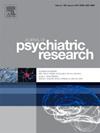青少年攻击行为的社会心理、时型和环境预测因素的综合分析:来自机器学习的见解
IF 3.7
2区 医学
Q1 PSYCHIATRY
引用次数: 0
摘要
青少年和年轻人的攻击行为是一个重要的公共卫生问题,与不良的教育、社会和心理健康结果相关。本研究旨在利用来自美国大型纵向队列的横断面数据集确定攻击的关键预测因素。结果是自我报告的攻击行为,预测因素跨越人口统计学、社会心理、行为和环境领域,包括不良生活事件、冲动、家庭冲突、同伴和学校环境以及时间类型。对多个模型进行了评估,包括线性回归、超调谐随机森林、调谐梯度增强机(GBM)、XGBoost和随机森林和GBM预测相结合的集成模型。所有模型都使用跨五个多重输入数据集的五倍交叉验证进行训练。线性回归预测准确率最高(r = 0.313;MSE = 40.76),其次是随机森林(r = 0.311;mse = 40.71)。集合模型和GBM模型表现出稍低的性能。在所有模型中,关键预测因素包括不良生活事件、延迟时型、同伴网络健康、家庭凝聚力和标准化家庭收入。这些发现强调了环境和心理压力因素对青少年攻击行为的影响,特别是有凝聚力的同伴和家庭关系的缓冲作用。尽管不同模型的预测精度相似,但机器学习方法在变量重要性排序和交互发现方面具有优势。结果强调了综合不同的社会心理、行为和环境措施的效用,以更好地理解复杂的行为结果并为有针对性的预防策略提供信息。本文章由计算机程序翻译,如有差异,请以英文原文为准。

Integrative analysis of psychosocial, chronotype, and environmental predictors of aggressive behavior in Adolescents: Insights from machine learning
Aggressive behavior in adolescents and young adults is a significant public health concern associated with adverse educational, social, and mental health outcomes. This study aimed to identify key predictors of aggression using a cross-sectional dataset from a large, longitudinal U.S. cohort. The outcome was self-reported aggressive behavior, and predictors spanned demographic, psychosocial, behavioral, and contextual domains, including adverse life events, impulsivity, family conflict, peer and school environments, and chronotype.Multiple models were evaluated, including linear regression, a hypertuned random forest, a tuned gradient boosting machine (GBM), XGBoost, and an ensemble model combining random forest and GBM predictions. All models were trained using five-fold cross-validation across five multiply imputed datasets. Linear regression achieved the highest predictive accuracy (r = 0.313; MSE = 40.76), followed closely by the random forest (r = 0.311; MSE = 40.71). The ensemble and GBM models showed slightly lower performance. Across models, key predictors included adverse life events, delayed chronotype, peer network health, family cohesion, and normalized household income.These findings underscore the contribution of environmental and psychological stressors to adolescent aggression, particularly the buffering role of cohesive peer and family relationships. Despite similar predictive accuracy across models, machine learning methods offered advantages for variable importance ranking and interaction discovery. Results highlight the utility of integrating diverse psychosocial, behavioral, and contextual measures to better understand complex behavioral outcomes and inform targeted prevention strategies.
求助全文
通过发布文献求助,成功后即可免费获取论文全文。
去求助
来源期刊

Journal of psychiatric research
医学-精神病学
CiteScore
7.30
自引率
2.10%
发文量
622
审稿时长
130 days
期刊介绍:
Founded in 1961 to report on the latest work in psychiatry and cognate disciplines, the Journal of Psychiatric Research is dedicated to innovative and timely studies of four important areas of research:
(1) clinical studies of all disciplines relating to psychiatric illness, as well as normal human behaviour, including biochemical, physiological, genetic, environmental, social, psychological and epidemiological factors;
(2) basic studies pertaining to psychiatry in such fields as neuropsychopharmacology, neuroendocrinology, electrophysiology, genetics, experimental psychology and epidemiology;
(3) the growing application of clinical laboratory techniques in psychiatry, including imagery and spectroscopy of the brain, molecular biology and computer sciences;
 求助内容:
求助内容: 应助结果提醒方式:
应助结果提醒方式:


